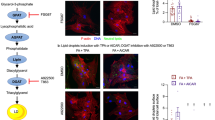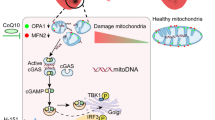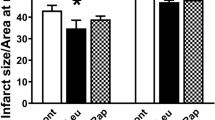Abstract
The stimulation of glucose transport by metabolic stress is an important determinant of myocardial susceptibility to ischemia and reperfusion injury. Stimulation of glucose transport is markedly impaired in cardiomyocytes chronically exposed to excess free fatty acids (FFA), as occurs in vivo in type 2 diabetes. To determine whether chronic low-grade activation of AMP-activated kinase (AMPK) improves substrate metabolism in cardiomyocytes exposed to FFA, isolated cultured cardiomyocytes were exposed for 7 days to FFA ± the AMPK agonist 5-aminoimidazole-4-carboxamide ribonucleoside (AICAR). Glucose transport and glycolysis were then measured during acute metabolic stress provoked by oligomycin. Chronic treatment with AICAR improved basal and oligomycin-stimulated glucose transport in FFA-exposed but not in control cardiomyocytes. Similarly, basal and oligomycin-stimulated glycolysis was reduced in FFA-exposed cardiomyocytes but restored by chronic AICAR treatment. Conversely, fatty acid oxidation was increased in FFA-exposed cardiomyocytes and reduced by chronic AICAR treatment. Chronic AICAR treatment induced in FFA-exposed cardiomyocytes the biogenesis of numerous lipid droplets. Curiously, whereas acute treatment of cardiomyocytes with AICAR increased phosphorylation of the AMPKα subunit on T172, a classical marker of AMPK activation, chronic AICAR treatment almost completely obliterated T172 phosphorylation. However, phosphorylation of the AMPK target protein raptor on S792 was reduced in FFA-exposed cardiomyocytes but restored by AICAR treatment. In conclusion, chronic AICAR treatment induces a metabolic shift in FFA-exposed cardiomyocytes, characterized by improved glucose transport and glycolysis and redirection of fatty acids towards neutral storage. Such metabolic changes in vivo could protect the hearts of patients with type 2 diabetes against ischemia-reperfusion injury.









Similar content being viewed by others
References
Alegria JR, Miller TD, Gibbons RJ, Yi Q-L, Yusuf S (2007) Infarct size, ejection fraction, and mortality in diabetic patients with acute myocardial infarction treated with thrombolytic therapy. Am Heart J 154:743–750. https://doi.org/10.1016/j.ahj.2007.06.020
Asrih M, Pellieux C, Papageorgiou I, Lerch R, Montessuit C (2011) Role of ERK1/2 activation in microtubule stabilization and glucose transport in cardiomyocytes. Am J Physiol Endocrinol Metab 301:E836–E843. https://doi.org/10.1152/ajpendo.00160.2011
Asrih M, Lerch R, Papageorgiou I, Pellieux C, Montessuit C (2012) Differential regulation of stimulated glucose transport by free fatty acids and PPARα or -δ agonists in cardiac myocytes. Am J Physiol Endocrinol Metab 302:E872–E884. https://doi.org/10.1152/ajpendo.00427.2011
Benjamini Y, Yekutieli D (2005) False discovery rate-adjusted multiple confidence intervals for selected parameters. JASA 100:71–81. https://doi.org/10.1198/016214504000001907
Bertrand L, Ginion A, Beauloye C, Hebert AD, Guigas B, Hue L, Vanoverschelde J-L (2006) AMPK activation restores the stimulation of glucose uptake in an in vitro model of insulin-resistant cardiomyocytes via the activation of protein kinase B. Am J Physiol Heart Circ Physiol 291:H239–H250
Chabowski A, Momken I, Coort SL, Calles-Escandon J, Tandon NN, Glatz JF, Luiken JJ, Bonen A (2006) Prolonged AMPK activation increases the expression of fatty acid transporters in cardiac myocytes and perfused hearts. Mol Cell Biochem 288:201–212. https://doi.org/10.1007/s11010-006-9140-8
Clavijo LC, Pinto TL, Kuchulakanti PK, Torguson R, Chu WW, Satler LF, Kent KM, Suddath WO, Pichard AD, Waksman R (2006) Metabolic syndrome in patients with acute myocardial infarction is associated with increased infarct size and in-hospital complications. Cardiovas Revasc Med 7:7–11. https://doi.org/10.1016/j.carrev.2005.10.007
Claycomb WC, Palazzo MC (1980) Culture of the terminally differentiated adult cardiac muscle cell: a light and scanning electron microscope study. Dev Biol 80:466–482. https://doi.org/10.1016/0012-1606(80)90419-4
Corton JM, Gillespie JG, Hawley SA, Hardie DG (1995) 5-Aminoimidazole-4-carboxamide ribonucleoside. A specific method for activating AMP-activated protein kinase in intact cells? Eur J Biochem 229:558–565. https://doi.org/10.1111/j.1432-1033.1995.0558k.x
Coughlan KA, Valentine RJ, Ruderman NB, Saha AK (2014) AMPK activation: a therapeutic target for type 2 diabetes? Diabetes Metab Syndr Obes 7:241–253. https://doi.org/10.2147/DMSO.S43731
Crute BE, Seefeld K, Gamble J, Kemp BE, Witters LA (1998) Functional domains of the α1 catalytic subunit of the AMP-activated protein kinase. J Biol Chem 273:35347–35354. https://doi.org/10.1074/jbc.273.52.35347
Dyntar D, Eppenberger-Eberhardt M, Maedler K, Pruschy M, Eppenberger HM, Spinas GA, Donath MY (2001) Glucose and palmitic acid induce degeneration of myofibrils and modulate apoptosis in rat adult cardiomyocytes. Diabetes 50:2105–2113
Eppenberger HM, Hertig C, Eppenberger-Eberhardt M (1994) Adult rat cardiomyocytes in culture. A model system to study the plasticity of the differentiated cardiac phenotype at the molecular and cellular levels. Trends Cardiovas Med 4:187–193
Eppenberger-Eberhardt M, Flamme I, Kurer V, Eppenberger HM (1990) Reexpression of α-smooth muscle actin isoform in cultured adult rat cardiomyocytes. Dev Biol 139:269–278. https://doi.org/10.1016/0012-1606(90)90296-U
Ginion A, Auquier J, Benton CR, Mouton C, Vanoverschelde J-L, Hue L, Horman S, Beauloye C, Bertrand L (2011) Inhibition of the mTOR/p70S6K pathway is not involved in the insulin-sensitizing effect of AMPK on cardiac glucose uptake. Am J Physiol Heart Circ Physiol 301:H469–H477. https://doi.org/10.1152/ajpheart.00986.2010
Goodman M, Liu Z, Zhu P, Li J (2014) AMPK activators as a drug for diabetes, cancer and cardiovascular disease. Pharm Regul Aff 3:118. https://doi.org/10.4172/2167-7689.1000118
Gwinn DM, Shackelford DB, Egan DF, Mihaylova MM, Mery A, Vasquez DS, Turk BE, Shaw RJ (2008) AMPK phosphorylation of raptor mediates a metabolic checkpoint. Mol Cell 30:214–226. https://doi.org/10.1016/j.molcel.2008.03.003
Hardie DG, Ross FA, Hawley SA (2012) AMPK: a nutrient and energy sensor that maintains energy homeostasis. Nat Rev Mol Cell Biol 13:251–262
Harris L-ALS, Skinner JR, Wolins NE (2013) Imaging of neutral lipids and neutral lipid associated proteins. Methods Cell Biol 116:213–226. https://doi.org/10.1016/b978-0-12-408051-5.00011-5
Hickson-Bick DLM, Buja ML, McMillin JB (2000) Palmitate-mediated alterations in the fatty acid metabolism of rat neonatal cardiac myocytes. J Mol Cell Cardiol 32:511–519
Horman S, Vertommen D, Heath R, Neumann D, Mouton V, Woods A, Schlattner U, Wallimann T, Carling D, Hue L, Rider MH (2006) Insulin antagonizes ischemia-induced Thr172 phosphorylation of AMP-activated protein kinase a-subunits in heart via hierarchical phosphorylation of Ser485/491. J Biol Chem 281:5335–5340
Iozzo P, Chareonthaitawee P, Dutka D, Betteridge DJ, Ferrannini E, Camici PG (2002) Independent association of type 2 diabetes and coronary artery disease with myocardial insulin resistance. Diabetes 51:3020–3024. https://doi.org/10.2337/diabetes.51.10.3020
Kaczmarczyk SJ, Andrikopoulos S, Favaloro J, Domenighetti AA, Dunn A, Ernst M, Grail D, Fodero-Tavoletti M, Huggins CE, Delbridge LMD, Zajac JD, Proietto J (2003) Threshold effects of glucose transporter-4 (GLUT4) deficiency on cardiac glucose uptake and development of hypertrophy. J Mol Endocrinol 31:449–459
Lejay A, Fang F, John R, Van JAD, Barr M, Thaveau F, Chakfe N, Geny B, Scholey JW (2016) Ischemia reperfusion injury, ischemic conditioning and diabetes mellitus. J Mol Cell Cardiol 91:11–22. https://doi.org/10.1016/j.yjmcc.2015.12.020
Liemburg-Apers DC, Wagenaars JAL, Smeitink JAM, Willems PHGM, Koopman WJH (2016) Acute stimulation of glucose influx upon mitoenergetic dysfunction requires LKB1, AMPK, Sirt2 and mTOR–RAPTOR. J Cell Sci 129:4411–4423. https://doi.org/10.1242/jcs.194480
Listenberger LL, Han X, Lewis SE, Cases S, Farese RVJ, Ory DS, Schaffer JE (2003) Triglyceride accumulation protects against fatty acid-induced lipotoxicity. Proc Natl Acad Sci U S A 100:3077–3082
Luiken JJFP, Vertommen D, Coort SLM, Habets DDJ, El Hasnaoui M, Pelsers MML, Viollet B, Bonen A, Hue L, Rider MH, Glatz JFC (2008) Identification of protein kinase D as a novel contraction-activated kinase linked to GLUT4-mediated glucose uptake, independent of AMPK. Cell Signal 20:543–556
Manning NJ, Olpin SE, Pollitt RJ, Webley J (1990) A comparison of [9,10-3H]palmitic and [9,10-3H]myristic acids for the detection of defects of fatty acid oxidation in intact cultured fibroblasts. J Inherit Metab Dis 13:58–68
Marsin A-S, Bertrand L, Rider MH, Deprez J, Beauloye C, Vincent MF, Van den Berghe G, Carling D, Hue L (2000) Phosphorylation and activation of heart PFK-2 by AMPK has a role in the stimulation of glycolysis during ischaemia. Curr Biol 10:1247–1255
Montessuit C, Papageorgiou I, Campos L, Lerch R (2006) Retinoic acids increase expression of GLUT4 in dedifferentiated and hypertrophied cardiac myocytes. Basic Res Cardiol 101:27–35
Montessuit C, Papageorgiou I, Lerch R (2008) Nuclear receptors agonists improve insulin responsiveness in cultured cardiomyocytes through enhanced signaling and preserved cytoskeletal architecture. Endocrinology 149:1064–1074. https://doi.org/10.1210/en.2007-0656
Narkar VA, Downes M, Yu RT, Embler E, Wang Y-X, Banayo E, Mihaylova MM, Nelson MC, Zou Y, Juguilon H, Kang H, Shaw RJ, Evans RM (2008) AMPK and PPARδ agonists are exercise mimetics. Cell 134:405–415. https://doi.org/10.1016/j.cell.2008.06.051
Papageorgiou I, Viglino C, Brulhart-Meynet M-C, James RW, Lerch R, Montessuit C (2016) Impaired stimulation of glucose transport in cardiac myocytes exposed to very low-density lipoproteins. Nutr Metab Cardiovasc Dis 26:614–622. https://doi.org/10.1016/j.numecd.2016.01.010
Park SH, Gammon SR, Knippers JD, Paulsen SR, Rubink DS, Winder WW (2002) Phosphorylation-activity relationships of AMPK and acetyl-CoA carboxylase in muscle. J Appl Physiol 92:2475–2482. https://doi.org/10.1152/japplphysiol.00071.2002
Pereira MJ, Palming J, Rizell M, Aureliano M, Carvalho E, Svensson MK, Eriksson JW (2012) mTOR inhibition with rapamycin causes impaired insulin signalling and glucose uptake in human subcutaneous and omental adipocytes. Mol Cell Endocrinol 355:96–105. https://doi.org/10.1016/j.mce.2012.01.024
Pinter K, Grignani RT, Watkins H, Redwood C (2013) Localisation of AMPK γ subunits in cardiac and skeletal muscles. J Muscle Res Cell Motil 34:369–378. https://doi.org/10.1007/s10974-013-9359-4
Povlsen JA, Løfgren B, Dalgas C, Birkler RID, Johannsen M, Støttrup NB, Bøtker HE (2013) Protection against myocardial ischemia-reperfusion injury at onset of type 2 diabetes in Zucker diabetic fatty rats is associated with altered glucose oxidation. PLoS One 8:e64093. https://doi.org/10.1371/journal.pone.0064093
Readnower RD, Brainard RE, Hill BG, Jones SP (2012) Standardized bioenergetic profiling of adult mouse cardiomyocytes. Physiol Genomics 44:1208–1213. https://doi.org/10.1152/physiolgenomics.00129.2012
Rosenblatt-Velin N, Lerch R, Papageorgiou I, Montessuit C (2004) Insulin resistance in adult cardiomyocytes undergoing dedifferentiation: role of GLUT4 expression and translocation. FASEB J 18:872–874. https://doi.org/10.1096/fj.03-1095fje
Rossner M, Yamada KM (2004) What's in a picture? The temptation of image manipulation. J Cell Biol 166:11–15
Russell RR, Bergeron R, Shulman GI, Young LH (1999) Translocation of myocardial GLUT-4 and increased glucose uptake through activation of AMPK by AICAR. Am J Physiol Heart Circ Physiol 277:H643–H649
Russell RR, Li J, Coven DL, Pypaert M, Zechner C, Palmeri M, Giordano FJ, Mu J, Birnbaum MJ, Young LH (2004) AMP-activated protein kinase mediates ischemic glucose uptake and prevents postischemic cardiac dysfunction, apoptosis, and injury. J Clin Invest 114:495–503. https://doi.org/10.1172/JCI200419297
Salvadó L, Coll T, Gómez-Foix AM, Salmerón E, Barroso E, Palomer X, Vázquez-Carrera M (2013) Oleate prevents saturated-fatty-acid-induced ER stress, inflammation and insulin resistance in skeletal muscle cells through an AMPK-dependent mechanism. Diabetologia 56:1372–1382. https://doi.org/10.1007/s00125-013-2867-3
Ségalen C, Longnus SL, Baetz D, Counillon L, Obberghen EV (2008) 5-Aminoimidazole-4-carboxamide-1-β-d-ribofuranoside reduces glucose uptake via the inhibition of Na+/H+ exchanger 1 in isolated rat ventricular cardiomyocytes. Endocrinology 149:1490–1498. https://doi.org/10.1210/en.2007-1326
Sozio MS, Lu C, Zeng Y, Liangpunsakul S, Crabb DW (2011) Activated AMPK inhibits PPAR-α and PPAR-γ transcriptional activity in hepatoma cells. Am J Physiol Gastrointest Liver Physiol 301:G739–G747. https://doi.org/10.1152/ajpgi.00432.2010
Steinbusch LKM, Wijnen W, Schwenk RW, Coumans WA, Hoebers NTH, Ouwens DM, Diamant M, Bonen A, Glatz JFC, Luiken JJFP (2010) Differential regulation of cardiac glucose and fatty acid uptake by endosomal pH and actin filaments. Am J Physiol Cell Physiol 298:C1549–C1559. https://doi.org/10.1152/ajpcell.00334.2009
Steinbusch LKM, Dirkx E, Hoebers NTH, Roelants V, Foretz M, Viollet B, Diamant M, van Eys G, Ouwens DM, Bertrand L, Glatz JFC, Luiken JJFP (2012) Overexpression of AMP-activated protein kinase or protein kinase D prevents lipid-induced insulin resistance in cardiomyocytes. J Mol Cell Cardiol 55:165–173. https://doi.org/10.1016/j.yjmcc.2012.11.005
TeSlaa T, Teitell MA (2014) Techniques to monitor glycolysis. In: Galluzzi L, Kroemer G (eds) Methods in enzymology, vol 542. Academic Press, Cambridge, pp 91–114. https://doi.org/10.1016/B978-0-12-416618-9.00005-4
Tian R, Abel ED (2001) Responses of GLUT4-deficient hearts to ischemia underscore the importance of glycolysis. Circulation 103:2961–2966. https://doi.org/10.1161/01.CIR.103.24.2961
van der Lee KAJM, Vork MM, De Vries JE, Willemsen PHM, Glatz JFC, Reneman RS, Van der Vusse GJ, Van Bilsen M (2000) Long-chain fatty acid-induced changes in gene expression in neonatal cardiac myocytes. J Lipid Res 41:41–47
Viglino C, Montessuit C (2017) A role for focal adhesion kinase in the stimulation of glucose transport in cardiomyocytes. J Cell Biochem 118:670–677. https://doi.org/10.1002/jcb.25655
Viglino C, Khoramdin B, Praplan G, Montessuit C (2017) Pleiotropic effects of chronic phorbol ester treatment to improve glucose transport in insulin-resistant cardiomyocytes. J Cell Biochem 118:4716–4727. https://doi.org/10.1002/jcb.26139
Wang L, Rolfe M, Proud CG (2003) Ca2+-independent protein kinase C activity is required for α1-adrenergic-receptor-mediated regulation of ribosomal protein S6 kinases in adult cardiomyocytes. Biochem J 373:603–611. https://doi.org/10.1042/bj20030454
Willows R, Sanders MJ, Xiao B, Patel BR, Martin SR, Read J, Wilson JR, Hubbard J, Gamblin SJ, Carling D (2017) Phosphorylation of AMPK by upstream kinases is required for activity in mammalian cells. Biochem J 474:3059–3073. https://doi.org/10.1042/BCJ20170458
Witters LA, Kemp BE (1992) Insulin activation of acetyl-CoA carboxylase accompanied by inhibition of the 5'-AMP-activated protein kinase. J Biol Chem 267:2864–2867
Zhou G, Myers R, Li Y, Chen Y, Shen X, Fenyk-Melody J, Wu M, Ventre J, Doebber T, Fujii N, Musi N, Hirshman MF, Goodyear LJ, Moller DE (2001) Role of AMP-activated protein kinase in mechanism of metformin action. J Clin Invest 108:1167–1174
Funding
This work was made possible by grants from the Swiss National Science Foundation (no. 310030_146537 to CM), the “Fondation Carlos et Elsie de Reuter” (no. 594 to CM), and the “Fondation pour la Recherche sur le Diabète” (to CM).
Author information
Authors and Affiliations
Corresponding author
Ethics declarations
Conflict of interest
The authors declare that they have no conflict of interest.
Ethics statement
All applicable international, national, and/or institutional guidelines for the care and use of animals were followed.
The ethical committee of the Geneva University School of Medicine and the Geneva State Veterinary Office approved the study protocol (authorization no. GE/51/16 and no. GE/217/17), which conforms to the Guide for the Care and Use of Laboratory Animals published by the National Institutes of Health (NIH Publication No. 85-23, revised 1996).
This article does not contain any studies with human participants performed by any of the authors.
Additional information
Publisher’s note
Springer Nature remains neutral with regard to jurisdictional claims in published maps and institutional affiliations.
Rights and permissions
About this article
Cite this article
Viglino, C., Foglia, B. & Montessuit, C. Chronic AICAR treatment prevents metabolic changes in cardiomyocytes exposed to free fatty acids. Pflugers Arch - Eur J Physiol 471, 1219–1234 (2019). https://doi.org/10.1007/s00424-019-02285-0
Received:
Revised:
Accepted:
Published:
Issue Date:
DOI: https://doi.org/10.1007/s00424-019-02285-0




